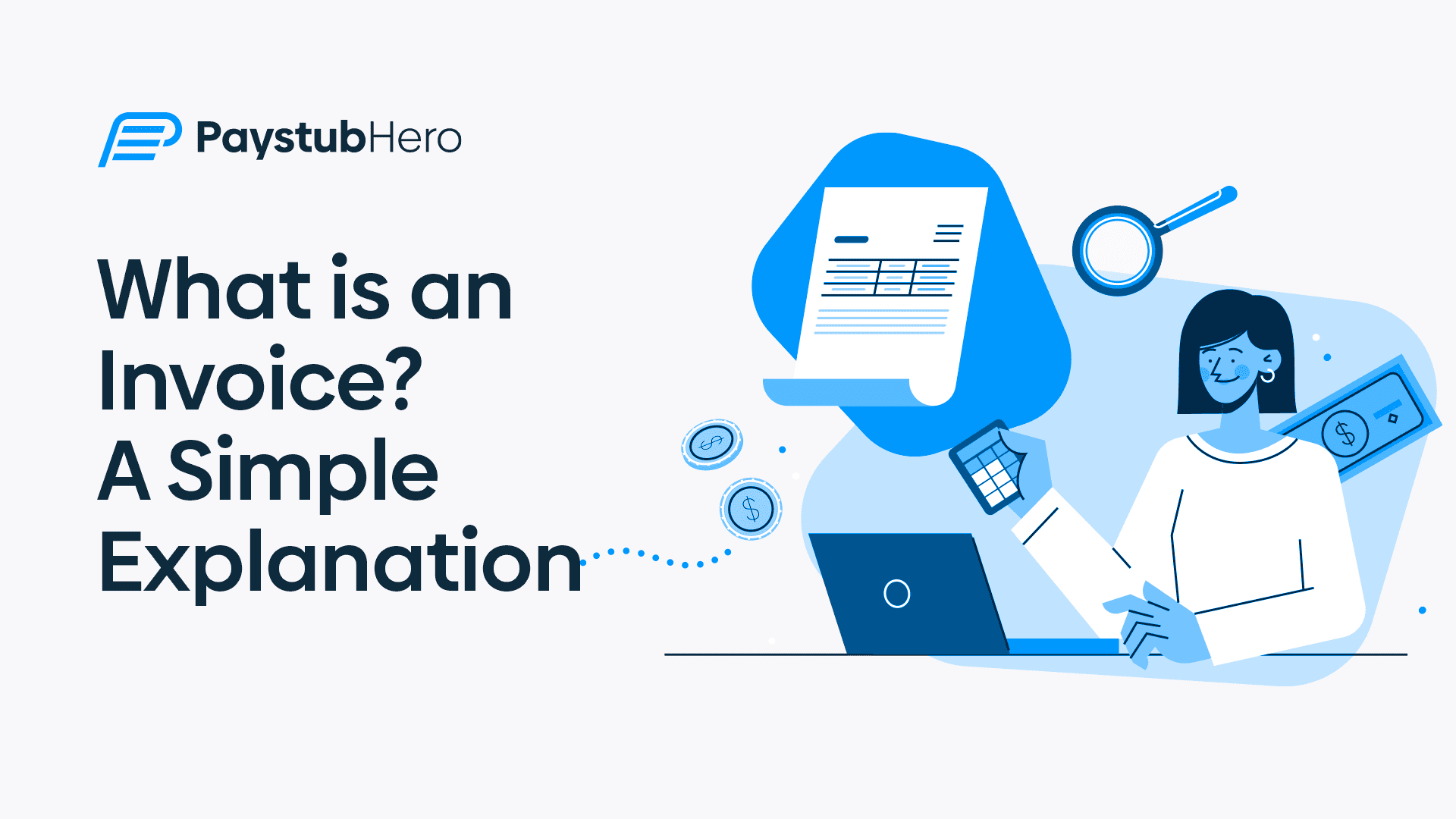An invoice is basically a receipt businesses use to request payment. It tells the customer what they owe for the goods or services they received.
This article will explain invoices, their purpose, the information they typically include, and the different types of invoices.
Understanding Invoices
As mentioned before, an invoice is a detailed bill/receipt a business gives to a customer. It’s a formal way of saying, “You owe me money for this!”
But, unlike a receipt you might get at the grocery store, an invoice has more information. It breaks down exactly what you owe money for, whether it’s products you bought or services you received.
Here’s an example:
Let’s say you hired Paystub Hero to create your paycheck stubs. The invoice Paystub Hero sends you would be a breakdown of their service.
To make it even clearer, here’s what the Paystub Hero’s invoice will contain:
Sample Invoice from Paystub Hero
Invoice Number: 2024-05-001 (This is a unique code for this specific invoice)
Invoice Date: May 25, 2024
Bill To:
• Your Name
• Your Address
From:
• Paystub Hero Inc.
• Their Address
Description of Services:
• Creation of 10 custom paycheck stubs (This tells you what service you received)
• Complex design fee (This could be used if the custom paycheck stubs involved fancy designs or logos that required additional design work.)
Price:
• Per-stub fee: $5 x 10 = $50 (This shows the cost of each service and the total)
• Complex design fee: $10 (This lists any additional charges)
Sub Total: $60
Tax (if applicable): $4.20 (This may vary depending on your location)
Total: $64.20
Payment Due Date: June 10, 2024 (This tells you when the money needs to be paid)
Payment Methods:
• Check
• Online payment (This tells you how you can pay them)
Here is a simple invoice table for the above invoice:
| Description | Amount |
| Paystub Creation (10 stubs) | $5 x 10 = $50 ($60) |
| Complex Design Fee | $10 |
| Subtotal | $60 |
| Tax | $4.20 |
| Total | $64.20 |
This is a basic example, but most invoices include similar information. It’s an easy way for the business and the customer to see what was bought, how much it costs, and when the payment is due.
Let’s look more closely at the contents of an invoice.
What is an Invoice: Key Information Included
Here’s a breakdown of the vital information included in an invoice.
Basic Information:
• Invoice: Clearly states it’s an invoice, so there’s no confusion about the document’s purpose.
• Your Business Info: Your company name, address, and contact details (like phone number or email). The info lets customers know who they’re paying and how to reach you.
• Customer Info: The customer’s business name, address, and contact details. The part ensures the bill reaches the right person or company.
What’s Owed:
• Invoice Number: A unique number assigned to this specific bill. This helps track the bill and avoid confusion if you have multiple invoices for the same customer.
• Invoice Date: The date the invoice is issued. This establishes when the billing process starts.
• Payment Terms: How long the customer has to pay (due date), any early payment discounts, or late payment penalties. The terms explain when payment is due and any rewards or penalties that might come with it.
Breakdown of Charges:
• Itemized List: A clear description of the goods or services provided. This list tells the customer exactly what they’re being charged for.
• Quantity & Price (Unit Price): How many of each item and the price per item. This breaks down the cost of each good or service.
• Date Delivered/Service Performed (optional): When the goods were delivered or the service was completed (not always included). This can help track purposes, especially if there’s a gap between the bill date and the service.
Totals: What is an Invoice and How to Calculate It:
• Subtotal: The cost of the items or services before taxes and other charges. This is the sum of the quantities multiplied by the unit prices.
• Taxes: Any applicable sales tax or VAT. Taxes may vary depending on your location and the type of good or service.
• Total Amount Due: The final amount the customer owes, including all charges. This is the most important number for the customer, as it’s the total they need to pay.
Optional Extras:
• Notes: Any additional information relevant to the bill, like purchase order references or special instructions. Notes can be a catch-all for anything that doesn’t fit elsewhere on the bill.
Different Types of it’s
Invoices come in several types. The most common are:
• Standard Invoice
Also called regular invoice or sales bill, it is the most common type used for one-time transactions of goods or services.
It includes basic information such as seller and buyer details and a description of the products or services. It also shows the total amount due and payment terms.
• Credit bill
A credit invoice also called a credit memo or credit note, is issued to offer a discount, refund, or correct a previous mistake.
For example, if you charged a customer for 10 items but only ordered 5, you would issue a credit bill for the 5 items they didn’t receive.
• Debit Invoice
Used for an additional charge not included in the original invoice. If a customer exceeds their agreed-upon hours for a project, you might send a debit invoice for the extra time.
Used for international transactions. It includes additional information customs officials require, such as a description of the goods, their value, and the country of origin.
• Retainer Invoice
Sent to collect a prepayment for a service that will be provided. This is common for freelance work or consulting services.
• Interim Invoice
A partial bill issued for a large project before completion allows the seller to be paid for work already done.
• Final Invoice
Issued after a project is completed, showing the total amount due, considering any previous retainer or interim invoices.
Why are Invoices Important?
Whether you’re an entrepreneur or self-employed, it’s offer several benefits. Here are some of the advantages:
Get Paid on Time
An invoice clearly states what’s owed and when. It reminds the buyer (the client) to settle the bill, keeping cash flow healthy for the seller (the business sending the bill).
Stay Organized
Invoices record all your business transactions. They detail what was sold, the price, and to whom. The neat record helps both the seller and buyer track their income and expenses for easy record-keeping.
Legal Proof
Invoices serve as a binding agreement. They document the sale and what was agreed upon, protecting both parties in case of any disagreements.
If a payment becomes a dispute, a clear invoice is crucial evidence.
Tax Time Helpers
Come tax season, invoices are lifesavers. They provide documented proof of income for the seller and business expenses for the buyer.
This ensures accurate tax filing for everyone involved.
Speed Up Workflow with Paystub Hero Invoices!
Making professional invoices can take a lot of time, especially for busy entrepreneurs and freelancers. You’d rather spend time doing what you do best, not struggling with spreadsheets and design tools.
Paystub Hero can simplify your invoicing process and save you valuable time.
Our user-friendly platform lets you create professional, customized invoices in minutes. No design skills are required.
FAQs
Here are some common questions people ask about invoices:
What is an invoice used for?
An invoice is a request for payment sent by a seller to a buyer.
What is an invoice vs. receipt?
An invoice is issued before payment, while a receipt is proof of payment after a purchase.
What's the difference between an invoice and a bill?
An invoice is a formal document, while a bill can be a less formal way of referring to the amount owed.
Does invoice mean paid?
No, an invoice does not necessarily mean that the payment has been received.





